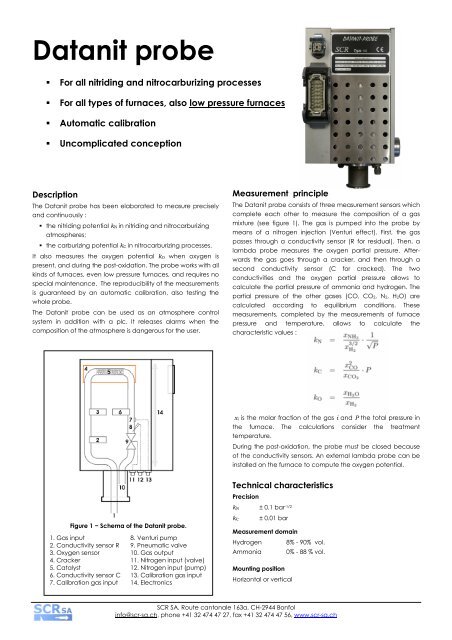Datanit probe - SCR SA
Datanit probe - SCR SA
Datanit probe - SCR SA
You also want an ePaper? Increase the reach of your titles
YUMPU automatically turns print PDFs into web optimized ePapers that Google loves.
<strong>Datanit</strong> <strong>probe</strong><br />
� For all nitriding and nitrocarburizing processes<br />
� For all types of furnaces, also low pressure furnaces<br />
� Automatic calibration<br />
� Uncomplicated conception<br />
Description<br />
The <strong>Datanit</strong> <strong>probe</strong> has been elaborated to measure precisely<br />
and continuously :<br />
� the nitriding potential kN in nitriding and nitrocarburizing<br />
atmospheres;<br />
� the carburizing potential kC in nitrocarburizing processes.<br />
It also measures the oxygen potential kO when oxygen is<br />
present, and during the post-oxidation. The <strong>probe</strong> works with all<br />
kinds of furnaces, even low pressure furnaces, and requires no<br />
special maintenance. The reproducibility of the measurements<br />
is guaranteed by an automatic calibration, also testing the<br />
whole <strong>probe</strong>.<br />
The <strong>Datanit</strong> <strong>probe</strong> can be used as an atmosphere control<br />
system in addition with a plc. It releases alarms when the<br />
composition of the atmosphere is dangerous for the user.<br />
Figure 1 − Schema of the <strong>Datanit</strong> <strong>probe</strong>.<br />
1. Gas input 8. Venturi pump<br />
2. Conductivity sensor R 9. Pneumatic valve<br />
3. Oxygen sensor 10. Gas output<br />
4. Cracker 11. Nitrogen input (valve)<br />
5. Catalyst 12. Nitrogen input (pump)<br />
6. Conductivity sensor C 13. Calibration gas input<br />
7. Calibration gas input 14. Electronics<br />
Measurement principle<br />
The <strong>Datanit</strong> <strong>probe</strong> consists of three measurement sensors which<br />
complete each other to measure the composition of a gas<br />
mixture (see figure 1). The gas is pumped into the <strong>probe</strong> by<br />
means of a nitrogen injection (Venturi effect). First, the gas<br />
passes through a conductivity sensor (R for residual). Then, a<br />
lambda <strong>probe</strong> measures the oxygen partial pressure. After-<br />
wards the gas goes through a cracker, and then through a<br />
second conductivity sensor (C for cracked). The two<br />
conductivities and the oxygen partial pressure allows to<br />
calculate the partial pressure of ammonia and hydrogen. The<br />
partial pressure of the other gases (CO, CO2, N2, H2O) are<br />
calculated according to equilibrium conditions. These<br />
measurements, completed by the measurements of furnace<br />
pressure and temperature, allows to calculate the<br />
characteristic values :<br />
xi is the molar fraction of the gas i and P the total pressure in<br />
the furnace. The calculations consider the treatment<br />
temperature.<br />
During the post-oxidation, the <strong>probe</strong> must be closed because<br />
of the conductivity sensors. An external lambda <strong>probe</strong> can be<br />
installed on the furnace to compute the oxygen potential.<br />
Technical characteristics<br />
Precision<br />
kN ± 0.1 bar -1/2<br />
kC ± 0.01 bar<br />
Measurement domain<br />
Hydrogen 8% - 90% vol.<br />
Ammonia 0% - 88 % vol.<br />
Mounting position<br />
Horizontal or vertical<br />
<strong>SCR</strong> <strong>SA</strong>, Route cantonale 163a, CH-2944 Bonfol<br />
info@scr-sa.ch, phone +41 32 474 47 27, fax +41 32 474 47 56, www.scr-sa.ch
Exterior influences<br />
None for temperature and pressure. The <strong>probe</strong> is heated at a<br />
temperature of 100°C.<br />
Treatment range<br />
Nitriding NH3 and two of the following gases : N2,<br />
NH3 c , N2O<br />
Nitrocarburizing NH3, N2 and two of the following gases :<br />
Post-oxidation<br />
CO2, endothermic gas, N2O, CH4, C3H8<br />
In option with the second lambda <strong>probe</strong> (at furnace exit).<br />
Measurement conditions<br />
Furnace temperature 450°C - 650°C<br />
200°C – 500°C in post-oxidation<br />
Gas pressure 200 – 1300 mbar absolute<br />
Temperature 10°C – 60°C<br />
Relative humidity 10% - 80% without condensation<br />
Fluid pressures<br />
Nitrogen minimum 5 bar<br />
Hydrogen 25% 0.8-1.5 bar<br />
Hydrogen 75% 0.8-1.5 bar<br />
Electrical power supply<br />
230V ± 10V in a box 400 mm x 400 mm x 200 mm<br />
Calculations<br />
Calculations must be done in a plc. Algorithms exists for the<br />
market leader plc.<br />
Measurement signal<br />
O2 4-20 mA / 0–5 V DC<br />
Conductivity R 4-20 mA / 0–5 V DC<br />
Conductivity C 4-20 mA / 0–5 V DC<br />
Temperatures 4-20 mA / 0–5 V DC<br />
Input-output needs in plc<br />
16 DO, 2 AO, 9 AI<br />
Other measurements<br />
Furnace pressure<br />
Internal temperature<br />
115°C and 850°C for the cracker<br />
Heating time<br />
30 min<br />
Calibration<br />
With independent module and 2 calibration gases<br />
Frequency before each treatment, minimum once week<br />
Duration 30 min<br />
Maintenance<br />
No particular maintenance is necessary<br />
Consumption<br />
Electric max. 250 W<br />
normal 100 W<br />
Fluid hydrogen 4 l by calibration<br />
Construction<br />
Materials<br />
nitrogen 4 l by calibration<br />
Galvanized aluminium and stainless steel<br />
Mechanical connection<br />
On the furnace Balzers DN40<br />
Electrical cabling<br />
Harting 32 poles<br />
Cabling for fluids<br />
Swagelok 6mm<br />
Dimensions<br />
Length of the aspiration tube 0.5 m - 2 m<br />
<strong>SCR</strong> <strong>SA</strong>, Route cantonale 163a, CH-2944 Bonfol<br />
info@scr-sa.ch, phone +41 32 474 47 27, fax +41 32 474 47 56, www.scr-sa.ch<br />
35 l by treatment hour<br />
50 l by purge hour<br />
External dimensions (H X L x L) 360 mm x 180 mm x 140 mm<br />
Weight<br />
9.8 kg<br />
Figure 2 − Example of the <strong>Datanit</strong> <strong>probe</strong> on a pit furnace



